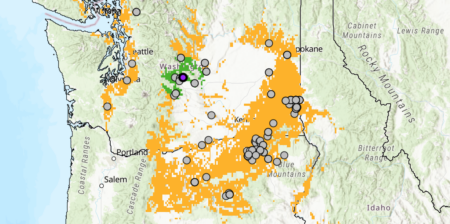There’s some new videos out that readers might be interested in. You can find an entertaining take on herbaria on the Atomic Frontier YouTube channel. And if you’re into amaranth, check out the latest roundup of resources on GRIN-U.
US CWR website ready for prime time
The data behind the recent paper Crop wild relatives of the United States require urgent conservation action, led by friend-of-the-blog Colin Khoury, is online in beta.

Do check it out, and fill out the user survey. Kudos to the first person to identify the crop wild relative in the map reproduced above. Orange shows the ex situ conservation gap. Genesys records just 3 accessions for this species.
New crop of crop maps crops up
Data viz wiz Erin has a bunch of excellent new maps of crop distributions in the USA over on her website. The data come from USDA Quick Stats, but her maps are way cooler. This, for examples, shows very strikingly what a powerhouse of agricultural biodiversity California is. Though I guess southern Texas comes close.
Nibbles: Gulf garden, Lettuce evaluation, Jordanian olive, Kenyan seeds, Hybrid animals, FAOSTAT news
- Qatari botanic garden is providing training in food security, and more. Good for them.
- The European Evaluation Network’s lettuce boffins have themselves a meeting. Pretty amazing this made it to FreshPlaza, and with that headline.
- The Jordan Times pretty much mangles what is a perfectly nice, though inevitably nuanced, story about the genetic depth of Jordan’s olives.
- In Kenya’s seed system, whatever is not forbidden in proposed new legislation…may not be enough.
- Conservation through hybridization.
- FAOSTAT now has a bit that gives you access to national agricultural census data. Which sounds quite important but give us a few days to check it.
Brainfood: First farmers, First dogs, First olives, Food sharing, Seed longevity, Seed germination, Conservation & climate change, Urban gardens, Seed movement, Machine learning, Web crawling, Imaging spectroscopy
- Ancient DNA maps ‘dawn of farming’. Hunter-gatherers from Europe and the Middle East mixed and settled down as farmers in Anatolia, then spread to Europe.
- The Australian dingo is an early offshoot of modern breed dogs. The dingo originated from grey wolves, and found itself isolated, much earlier than all other dog breeds.
- The first use of olives in Africa around 100,000 years ago. Hunter-gatherers used the wild olive long before they domesticated either it or the dog.
- Intestinal parasites in the Neolithic population who built Stonehenge (Durrington Walls, 2500 BCE). Neolithic people and their dogs ate the same things.
- Comparative seed longevity under genebank storage and artificial ageing: a case study in heteromorphic wheat wild relatives. Seeds of the same crop wild relatives species but with different shapes have different seed longevities.
- Stepping up to the thermogradient plate: a data framework for predicting seed germination under climate change. But do heteromorphic seeds have different germination requirements too? Here’s how to find out.
- Conservation interventions can benefit species impacted by climate change. Biodiversity was helped with the effects of climate change in 30% of cases, especially if interventions were targeted on specific species. Genebanks available for comment.
- Urban conservation gardening in the decade of restoration. Speaking of interventions…
- South and/or north: an indigenous seed movement in South Korea and the multiple bases of food sovereignty. Wait, what about the genebank though?
- Perspectives in machine learning for wildlife conservation. Surely if you can use fancy tech and maths to monitor cheetahs, monitoring crop wild relative populations and landraces should be a doddle.
- Quantifying an online wildlife trade using a web crawler. Surely if you can crawl the web for evidence of illicit wildlife trade, crawling it to evidence of genetic erosion of crop diversity should be a doddle.
- Plant beta-diversity across biomes captured by imaging spectroscopy. How about capturing beta-diversity within crop fields, though? A doddle, no? We’ve come a long way since those first Anatolian farmers and their dingoes.
